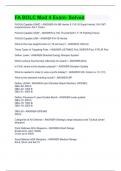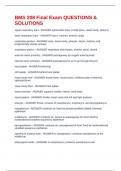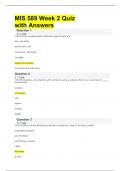Strategy
Lecture 1: Introduction
Outline Course
What is strategy about?
- Answer from the crowd: Setting goals/objectives and ways to achieve those goals/objectives.
- Answer from the professor: Positioning, performance, alliances, stakeholders
Also, it involves many dilemma’s and paradoxes.
Identifying the Strategy Issues
When looking at an organization, we can distinguish four levels of
strategic issues.
- On the network level: how do I position myself among the
competitors?
- On the corporate level: how do I fit several type of market
activities together?
- On the business level: how do I compete in the market?
- On the functional level: how do the departments look like?
There are two ways of looking at strategy:
- Tools-driven approach (SWOT; PESTL; BCG): doing analysis
resulting in the outcome of information (but doesn’t talk about
which perspective to take into consideration and therefore the
difference of solutions)
- Problem-driven approach: key strategy issues are identified and
examined from the perspective of the most appropriate theories.
What strategic issues exist:
- Strategizing: cognitive processes of individual strategists
- Missioning & visioning: purpose and input for strategic
activities
- Strategy content: combined decisions and choices that
lead a company into the future (e.g. effect of alliances on
resource-availability)
- Strategy process: the manner in which strategies come
about
- Strategy context: set of circumstances under which the
strategy content and the strategy process are determined
(e.g. dynamic or stable)
Managing strategy paradoxes
There are four type of strategy tensions and ways to deal with
strategic issues:
- Puzzles: when all information is available and one
assumes to be rational/analytical, the best solution can be
found
- Dilemma’s: make a choice between the two also based on
rational/analytics
- Trade-offs: given both worlds, can we find an optimal
solution (line)
- Paradoxes: getting the best of both worlds (distributive)
,A paradox has no answer or set of answers. The book provides six different ways to deal with a paradox:
- Navigating: focus on one contrary element at a time (e.g. seeking synergies, then looking for
responsiveness)
- Parallel processing: separate the contrary demands in different internal or external organizational units
(e.g. improving existing products, meanwhile developing new generations of products)
- Balancing: trade off elements of the opposing demands (e.g. following industry rules vs. changing
others)
- Juxtaposing: manage opposite demands (e.g. competing and collaborating (Apple vs. Samsung))
- Resolving: develop a new synthesis between competing demands (e.g. shareholder vs. societal value)
- Embracing: embrace and actively use the tension as a source of creativity and opportunity (e.g.
assigning opposite personalities in management team)
Readings
Each chapter is concluded with three articles, opposing or embracing the paradox of the approaches:
1. Complexity: The nature of real world problems’, from Chapter 1, R Mason and I Mitroff, Challenging
Strategic Planning Assumption → putting the planning school of strategy up for discussion
2. Managing strategic contradictions’ Wendy K Smith and Michael L Tushman, ‘Managing Strategic
Contradictions’ Organization Science, Vol. 16(5 → how managers deal with contradictions and how
to manage those contradictions
3. ‘Cultural constraints in management theories’, Geert Hofstede, from G Hofstede, ‘Cultural Constraints
in Management Theories’, Academy of Management Executive, Vol. 7(1) → do cultures matter? Can
we explain why different countries or companies look at strategic issues
Reading 1 → strategic issues can’t be approached form a planning perspective because it are not well defined
problems (many stakes/issues). Strategic problems are usually wicked, uncertainty, ambiguity,
interconnectedness, opposing views, conflicting interests. There is no one way solution.
Reading 2 → dealing with tensions/paradoxical frames. On the one hand finding the best solution out of the
two and on the other hand to integrate them. Balancing strategic contradictions which is about the distributive
results so the best chose of each the best and find the synergy of these bests. This can done with a so-called
team-focussed or leader-focussed approach (in both distributive & integrative decision making framed by
mental maps (beliefs, experience etc.) of the decisionmakers).
Reading 3 → putting countries but also organisations into horizon/ describing characteristics of these
according to Hofstede’s dimensions or Cameron & Quinn’s competing values framework (four major culture
types).
Dealing with paradoxes
Profitability (Friedman - shareholder) ↔ Responsibility (Freeman - stakeholder):
- To be an attractive investment, a firm must earn a higher return on the shareholder’s equity than could
be realized at a bank ↔ Acting in the interest of others, even when there is no legal imperative
Logical thinking (analytics) ↔ Creative thinking (learning by doing)
- The ability of managers to critically reflect on the assumptions they hold and to make their tacit beliefs
more explicit ↔ The ability of managers to abandon the rules governing sound argumentations and
generate new understandings
Market adaptation (adapt to developments) ↔ Resource leveraging (own direction)
- The ability to understand ‘the rules of the game’ in the market where one is operating ↔ Creating
value by controlling, disseminating assets across the business and organizational system
Business responsiveness (related business; exploitation) ↔ Multi-business synergy (splitting the risk)
- The ability to respond to the competitive demands of a specific business area in a timely and adequate
manner ↔ The additional value created by working in two or more business areas, over and above the
sum of business parts
,Inter-organizational competition ↔ Inter-organizational cooperation
- The act of working against each other, where two or more organizations’ goals are mutually exclusive
↔ The act of working together with each other, where two or more organizations’ goals are mutually
beneficial
Deliberate strategizing ↔ Strategy emergence
- The ability of acting intentionally; so thinking before acting ↔ The ability of thinking and acting at
the same time and letting strategy emerge
Revolutionary change ↔ Evolutionary change (gradually)
- Change processes that do not build on the status que, yet overthrow it ↔ Change processes whereby a
constant stream of moderate changes gradually accumulates over a long period of time
Exploitation ↔ Exploration
- Companies should focus on continuously improving their business model ↔ Companies should focus
on breakthrough innovations that change the rules of the competitive game
Firm compliance (follow the industry)↔ Strategic choice (make the industry)
- The ability of companies to understand and adapt themselves to their environments ↔ The ability to
act without regarding the rules of the game
Global synergy ↔ Local responsiveness
- The ability to create value by leveraging resources, integrating activities and aligning product offerings
across two or more countries ↔ The ability to remain attuned to specific national market demands,
responding adequately and timely to unique characteristics
Strategy
Lecture 2: Missioning & visioning
Why firms exist
- Answer from the crowd: Make money; respond to one’s competitive advantage
- Answer from the professor: Add value (purpose)
Ronald Coase came up with the transaction costs theory. This theory tries to explain why organizations
exist. Coase said that all actions taken are transactions and are cost-involved. When looking at transactions
and the costs involved with it, it can be observed that firms will start to specialize.
The ‘costs of using the price system’ came to be called the transaction costs.
The size of the firm is not its output (Q) but the number of transactions or activities within its boundaries.
Firms exist in order to economize on buying and selling everything.
Firms exist to reduce transaction costs.
Firms are formed when benefits can be obtained from individuals working as a team.
The sum of what individuals can produce as a team is sometimes greater than the sum of what they can
produce alone.
Defining organizations
An organization is an association of productive assets (including people) who voluntarily come together to
accomplish a set of goals. In the case of the business organization, this goal means gaining an economic
advantage. For these productive assets to come together to occur it must be ‘worth it’ for people and others
to be involved with the organization.
, Corporate mission (elements)
We need to create value but there is more, e.g.: the mission
(what does the organization stand for?) Besides, it is not only
about economical value creation but also socio-ecological
value creation. It is about identity, norms, values, a compass
etc. It is about the company’s business, its objectives and ways
to reach these objectives.
The corporate mission provides the function of direction,
legitimization (is it accepted by society; social viability) and
motivation.
Corporate vision (elements)
What is the position in the (near) future? It therefore describes the desired future state of the organization.
Envisioned contextual environment
Envisioned industry environment
Desired future organizational position
Time horizon
Corporate governance
The board of the organization with the main tasks/functions:
- Forming function: to create the mission & vision (together with others)
- Performance function: plan of action to achieve the goals derived from the mission & vision
- Conformance function: are we achieving the goals; monitoring
Forms of corporate governance:
- Board structure: two-tier (distinction between supervisory
board and executive board) or one-tier (integration of
supervisory board and executive board)
- Board membership: composition of the board
- Board tasks: tasks and authority of the board may vary
When the board and the owner have different views/goals then we are talking about an agency-principle
dilemma.
What is performance?
Depends on the context but for firms it means that companies successfully formulate and implement a value-
creating strategy. Balancing the paradox profitability & responsibility is crucial for the performance of a
firm.
Hierarchy of objectives
Once the mission and vision are clear, one translates this to the
target(s) (viability = targets). These can be divided in economic
and social targets. Based on that, sub-targets can be derived.
This should be taken into account for the performance. The
balance of these two depends on the situation and the
perspective.
Perspectives on organizations
Position Responsible to Therefore
Minimalist (Friedman, 1970) Stockholders / owners Maximizing profits → growth
Lecture 1: Introduction
Outline Course
What is strategy about?
- Answer from the crowd: Setting goals/objectives and ways to achieve those goals/objectives.
- Answer from the professor: Positioning, performance, alliances, stakeholders
Also, it involves many dilemma’s and paradoxes.
Identifying the Strategy Issues
When looking at an organization, we can distinguish four levels of
strategic issues.
- On the network level: how do I position myself among the
competitors?
- On the corporate level: how do I fit several type of market
activities together?
- On the business level: how do I compete in the market?
- On the functional level: how do the departments look like?
There are two ways of looking at strategy:
- Tools-driven approach (SWOT; PESTL; BCG): doing analysis
resulting in the outcome of information (but doesn’t talk about
which perspective to take into consideration and therefore the
difference of solutions)
- Problem-driven approach: key strategy issues are identified and
examined from the perspective of the most appropriate theories.
What strategic issues exist:
- Strategizing: cognitive processes of individual strategists
- Missioning & visioning: purpose and input for strategic
activities
- Strategy content: combined decisions and choices that
lead a company into the future (e.g. effect of alliances on
resource-availability)
- Strategy process: the manner in which strategies come
about
- Strategy context: set of circumstances under which the
strategy content and the strategy process are determined
(e.g. dynamic or stable)
Managing strategy paradoxes
There are four type of strategy tensions and ways to deal with
strategic issues:
- Puzzles: when all information is available and one
assumes to be rational/analytical, the best solution can be
found
- Dilemma’s: make a choice between the two also based on
rational/analytics
- Trade-offs: given both worlds, can we find an optimal
solution (line)
- Paradoxes: getting the best of both worlds (distributive)
,A paradox has no answer or set of answers. The book provides six different ways to deal with a paradox:
- Navigating: focus on one contrary element at a time (e.g. seeking synergies, then looking for
responsiveness)
- Parallel processing: separate the contrary demands in different internal or external organizational units
(e.g. improving existing products, meanwhile developing new generations of products)
- Balancing: trade off elements of the opposing demands (e.g. following industry rules vs. changing
others)
- Juxtaposing: manage opposite demands (e.g. competing and collaborating (Apple vs. Samsung))
- Resolving: develop a new synthesis between competing demands (e.g. shareholder vs. societal value)
- Embracing: embrace and actively use the tension as a source of creativity and opportunity (e.g.
assigning opposite personalities in management team)
Readings
Each chapter is concluded with three articles, opposing or embracing the paradox of the approaches:
1. Complexity: The nature of real world problems’, from Chapter 1, R Mason and I Mitroff, Challenging
Strategic Planning Assumption → putting the planning school of strategy up for discussion
2. Managing strategic contradictions’ Wendy K Smith and Michael L Tushman, ‘Managing Strategic
Contradictions’ Organization Science, Vol. 16(5 → how managers deal with contradictions and how
to manage those contradictions
3. ‘Cultural constraints in management theories’, Geert Hofstede, from G Hofstede, ‘Cultural Constraints
in Management Theories’, Academy of Management Executive, Vol. 7(1) → do cultures matter? Can
we explain why different countries or companies look at strategic issues
Reading 1 → strategic issues can’t be approached form a planning perspective because it are not well defined
problems (many stakes/issues). Strategic problems are usually wicked, uncertainty, ambiguity,
interconnectedness, opposing views, conflicting interests. There is no one way solution.
Reading 2 → dealing with tensions/paradoxical frames. On the one hand finding the best solution out of the
two and on the other hand to integrate them. Balancing strategic contradictions which is about the distributive
results so the best chose of each the best and find the synergy of these bests. This can done with a so-called
team-focussed or leader-focussed approach (in both distributive & integrative decision making framed by
mental maps (beliefs, experience etc.) of the decisionmakers).
Reading 3 → putting countries but also organisations into horizon/ describing characteristics of these
according to Hofstede’s dimensions or Cameron & Quinn’s competing values framework (four major culture
types).
Dealing with paradoxes
Profitability (Friedman - shareholder) ↔ Responsibility (Freeman - stakeholder):
- To be an attractive investment, a firm must earn a higher return on the shareholder’s equity than could
be realized at a bank ↔ Acting in the interest of others, even when there is no legal imperative
Logical thinking (analytics) ↔ Creative thinking (learning by doing)
- The ability of managers to critically reflect on the assumptions they hold and to make their tacit beliefs
more explicit ↔ The ability of managers to abandon the rules governing sound argumentations and
generate new understandings
Market adaptation (adapt to developments) ↔ Resource leveraging (own direction)
- The ability to understand ‘the rules of the game’ in the market where one is operating ↔ Creating
value by controlling, disseminating assets across the business and organizational system
Business responsiveness (related business; exploitation) ↔ Multi-business synergy (splitting the risk)
- The ability to respond to the competitive demands of a specific business area in a timely and adequate
manner ↔ The additional value created by working in two or more business areas, over and above the
sum of business parts
,Inter-organizational competition ↔ Inter-organizational cooperation
- The act of working against each other, where two or more organizations’ goals are mutually exclusive
↔ The act of working together with each other, where two or more organizations’ goals are mutually
beneficial
Deliberate strategizing ↔ Strategy emergence
- The ability of acting intentionally; so thinking before acting ↔ The ability of thinking and acting at
the same time and letting strategy emerge
Revolutionary change ↔ Evolutionary change (gradually)
- Change processes that do not build on the status que, yet overthrow it ↔ Change processes whereby a
constant stream of moderate changes gradually accumulates over a long period of time
Exploitation ↔ Exploration
- Companies should focus on continuously improving their business model ↔ Companies should focus
on breakthrough innovations that change the rules of the competitive game
Firm compliance (follow the industry)↔ Strategic choice (make the industry)
- The ability of companies to understand and adapt themselves to their environments ↔ The ability to
act without regarding the rules of the game
Global synergy ↔ Local responsiveness
- The ability to create value by leveraging resources, integrating activities and aligning product offerings
across two or more countries ↔ The ability to remain attuned to specific national market demands,
responding adequately and timely to unique characteristics
Strategy
Lecture 2: Missioning & visioning
Why firms exist
- Answer from the crowd: Make money; respond to one’s competitive advantage
- Answer from the professor: Add value (purpose)
Ronald Coase came up with the transaction costs theory. This theory tries to explain why organizations
exist. Coase said that all actions taken are transactions and are cost-involved. When looking at transactions
and the costs involved with it, it can be observed that firms will start to specialize.
The ‘costs of using the price system’ came to be called the transaction costs.
The size of the firm is not its output (Q) but the number of transactions or activities within its boundaries.
Firms exist in order to economize on buying and selling everything.
Firms exist to reduce transaction costs.
Firms are formed when benefits can be obtained from individuals working as a team.
The sum of what individuals can produce as a team is sometimes greater than the sum of what they can
produce alone.
Defining organizations
An organization is an association of productive assets (including people) who voluntarily come together to
accomplish a set of goals. In the case of the business organization, this goal means gaining an economic
advantage. For these productive assets to come together to occur it must be ‘worth it’ for people and others
to be involved with the organization.
, Corporate mission (elements)
We need to create value but there is more, e.g.: the mission
(what does the organization stand for?) Besides, it is not only
about economical value creation but also socio-ecological
value creation. It is about identity, norms, values, a compass
etc. It is about the company’s business, its objectives and ways
to reach these objectives.
The corporate mission provides the function of direction,
legitimization (is it accepted by society; social viability) and
motivation.
Corporate vision (elements)
What is the position in the (near) future? It therefore describes the desired future state of the organization.
Envisioned contextual environment
Envisioned industry environment
Desired future organizational position
Time horizon
Corporate governance
The board of the organization with the main tasks/functions:
- Forming function: to create the mission & vision (together with others)
- Performance function: plan of action to achieve the goals derived from the mission & vision
- Conformance function: are we achieving the goals; monitoring
Forms of corporate governance:
- Board structure: two-tier (distinction between supervisory
board and executive board) or one-tier (integration of
supervisory board and executive board)
- Board membership: composition of the board
- Board tasks: tasks and authority of the board may vary
When the board and the owner have different views/goals then we are talking about an agency-principle
dilemma.
What is performance?
Depends on the context but for firms it means that companies successfully formulate and implement a value-
creating strategy. Balancing the paradox profitability & responsibility is crucial for the performance of a
firm.
Hierarchy of objectives
Once the mission and vision are clear, one translates this to the
target(s) (viability = targets). These can be divided in economic
and social targets. Based on that, sub-targets can be derived.
This should be taken into account for the performance. The
balance of these two depends on the situation and the
perspective.
Perspectives on organizations
Position Responsible to Therefore
Minimalist (Friedman, 1970) Stockholders / owners Maximizing profits → growth









